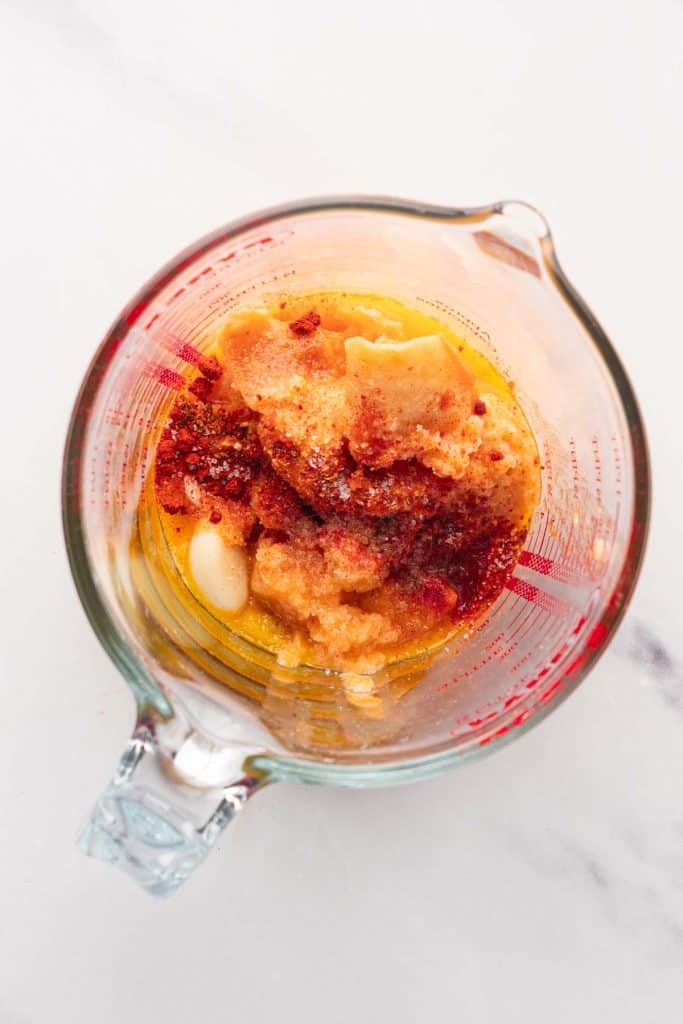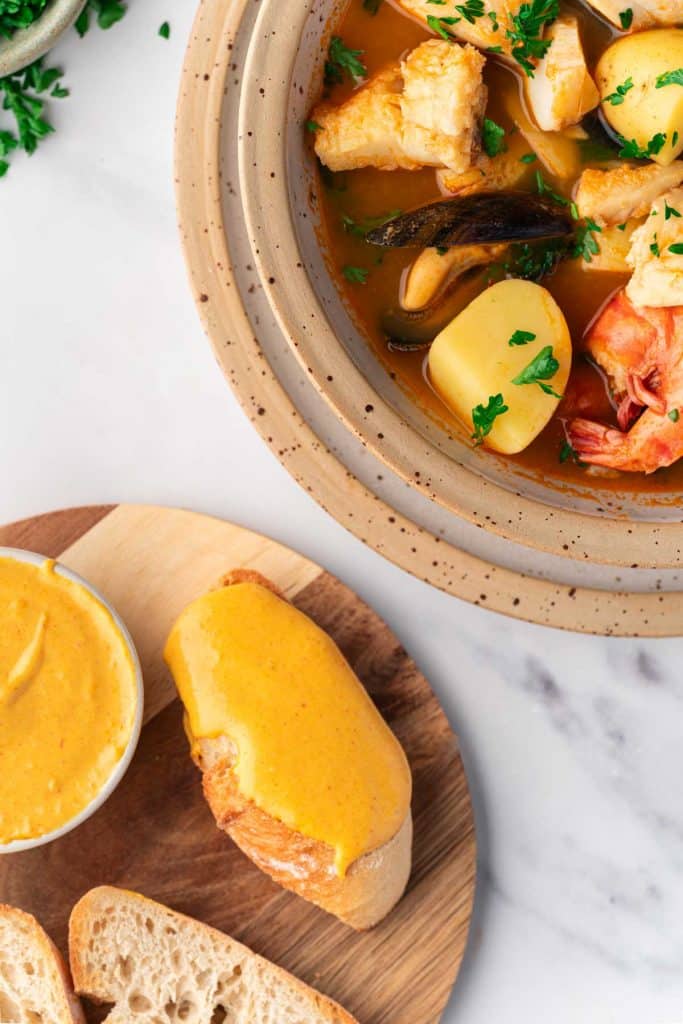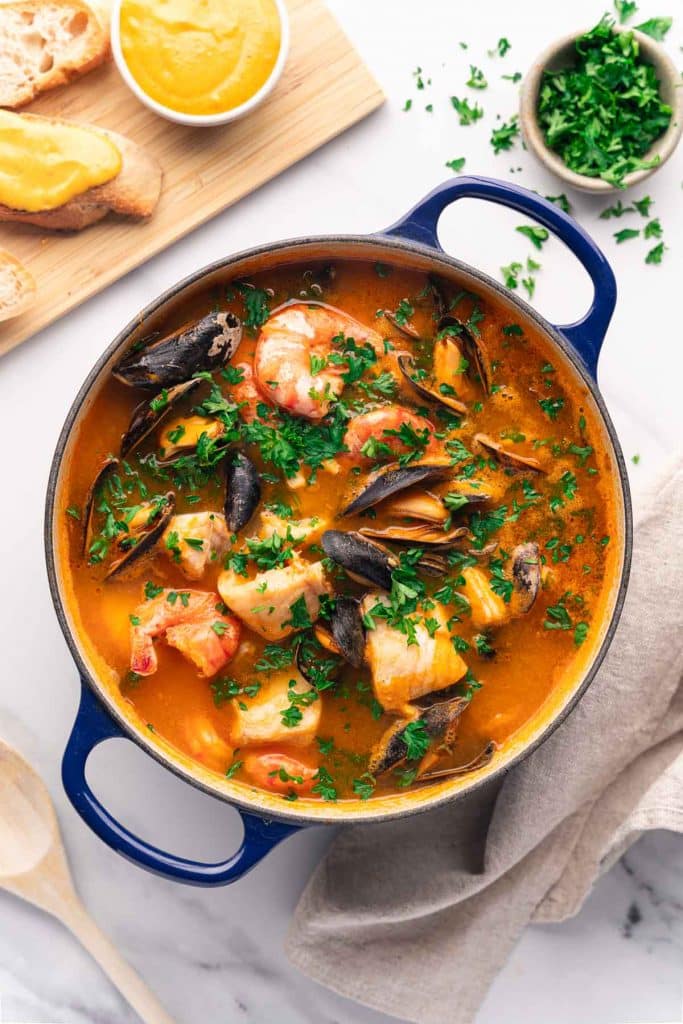French Rouille Sauce

Provençal rouille sauce is a culinary specialty of Provence, in the south of France. It’s a key component of the traditional bouillabaisse, the emblem of the city of Marseille. In fact, if you haven’t tried it yet, you’ve got to try my easy version of traditional French bouillabaisse! It’s one of my favorite recipes in French cuisine.
Rouille sauce isn’t just for bouillabaisse, this creamy, golden sauce is superb with seafood and adds a touch of flavor and color to any meal. Plus, it is relatively easy to prepare.
Table of Content
What is a Rouille sauce ?
Rouille (pronounced “roo-ee”) is a traditional French sauce that originates from the region of Provence. The name “rouille” comes from the French word for “rust,” which describes the sauce’s reddish-orange color.
It is a popular accompaniment to various seafood dishes and fish stews, particularly the well-known fish stew called Bouillabaisse (see my bouillabaisse recipe).
List of Ingredients
Rouille sauce is a mayonnaise seasoned with saffron, garlic and a few spices. All the ingredients are easy to find!

- Olive oil: Choose a good quality extra-virgin olive oil for the rouille mayonnaise. Its fruity and robust flavor will enhance the overall taste of the sauce. Avoid a super strong-tasting olive oil.
- Egg yolks: The egg yolks act as the emulsifier. They bind the olive oil and create a creamy texture for the mayonnaise. Use fresh, pasteurized eggs to minimize any food safety concerns.
- Dijon mustard: Essential ingredient in the preparation of mayonnaise and therefore of rouille. It also helps emulsify the sauce, making it creamy.
- Garlic cloves: Characteristic of rouille and Provencal cuisine in general. Use fresh garlic cloves, and if you prefer a milder taste, you can reduce the amount of garlic used.
- Saffron threads: This classic spice is a key ingredient in flavor and give the rouille its vibrant color.
- Paprika powder: Paprika adds smokiness and a mild red color to the rouille mayonnaise. Opt for sweet or smoked paprika, depending on your taste preferences.
- Cayenne pepper or Piment d’Espelette: Use cayenne pepper if you prefer a more widely available option, or go for Piment d’Espelette if you want a slightly milder, fruity spice with a touch of Basque flavor.
- White bread: This acts as a thickener and helps to give the rouille its thick texture. You can use stale or day-old bread.
- Water or stock: The liquid helps to soften the bread and make it easier to blend with the other ingredients.
How to Make a Rouille Sauce?
- Prepare the ingredients. Soak the bread in water or stock. If you are serving it with a bouillabaisse, use fish soup as a liquid. In a small bowl, combine the saffron threads with a few drops of lemon juice and let it sit for a few minutes to infuse. In the bowl of your food processor or in a small jar, add the egg yolks, garlic cloves, Dijon mustard, soaked bread, saffron with lemon juice, a pinch of salt, paprika, and piment d’Espelette.
- Blend the sauce. Using a hand blender or a food processor, blend the mixture until all the ingredients are well combined and you have a smooth paste. With the food processor still running, slowly drizzle in the olive oil in a steady stream. This will help emulsify the sauce and thicken it. Continue adding olive oil little by little until you achieve the desired consistency. The rouille should be creamy and slightly thick.
- Taste and serve. Taste the rouille and adjust the seasoning if needed, adding more paprika, piment d’espelette, or lemon juice according to your preference. Transfer the rouille to a serving bowl and refrigerate it for at least 30 minutes before serving. Chilling the rouille will enhance its flavors.


How to Serve Rouille ?
The best is to simply serve rouille on toasted baguette slices. I adore the strong taste in contrast with the bread.
If you’re serving rouille with bouillabaisse, you can not only serve the rouille on bread, but also add a teaspoon of rouille to your soup to add spice and deepen the flavor instantly.
I also love rouille with cold fish and seafood like shrimp. So good! It’s wonderful with a seafood platter, too, and really lifts all the seafood elements.

FAQ: Rouille Sauce
Provençal rouille sauce is a culinary specialty of Provence, in the south of France. It’s a key component of the traditional bouillabaisse, the emblem of the city of Marseille.
Choose Piment d’Espelette over the cayenne powder, or use only a tiny bit of cayenne.
Rouille and Aioli are French sauces with a mayonnaise base made with olive oil. Aioli is a simple garlic mayonnaise. In contrast, Rouille is a reddish-orange sauce with a unique flavor, incorporating saffron, garlic, cayenne pepper, and paprika. It is commonly served with fish and seafood dishes, such as the renowned Bouillabaisse.
No, it is not. To make it gluten-free, you must choose a slice of gluten-free bread to use in the recipe.
Don’t hesitate to leave me a comment, it always makes me happy!

You can also find me on Instagram, Facebook and TikTok to see behind the scenes of my blog
Recipe card
French Rouille Sauce
Click on the stars to rate!

Ingredients
- 2/3 cup olive oil (150 ml)
- 2 egg yolks
- 1 tbsp Dijon mustard
- 3 garlic cloves
- 6 Saffron threads
- 1 tsp paprika powder
- 1 tsp cayenne pepper or Piment d'Espelette
- 2 slices baguette or 1 slice of white bread
- 60 ml water or stock
Instructions
- Soak the bread in water or stock. If you are serving it with a bouillabaisse, use fish soup as a liquid.
- In a small bowl, combine the saffron threads with a few drops of lemon juice and let it sit for a few minutes to infuse.
- In the bowl of your food processor or in a small jar, add the egg yolks, garlic cloves, Dijon mustard, soaked bread, saffron with lemon juice, a pinch of salt, paprika, and piment d’Espelette.
- Using a hand blender or a food processor, Blend the mixture until all the ingredients are well combined and you have a smooth paste.
- With the food processor still running, slowly drizzle in the olive oil in a steady stream. This will help emulsify the sauce and thicken it.
- Continue adding olive oil little by little until you achieve the desired consistency. The rouille should be creamy and slightly thick.
- Taste the rouille and adjust the seasoning if needed, adding more paprika, piment d’espelette, or lemon juice according to your preference.
- Transfer the rouille to a serving bowl and refrigerate it for at least 30 minutes before serving. Chilling the rouille will enhance its flavors.
